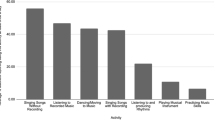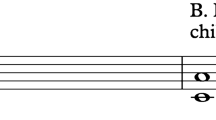Abstract
The purpose of this comparative case study was to investigate the use of music in two Reggio-inspired preschools in the United States. I used purposeful sampling to select two sites that represented contrasting sociocultural contexts: one urban school serving a Latino population from low socioeconomic backgrounds and one suburban early childhood center serving a Caucasian population from high socioeconomic backgrounds. Data were collected over a 2-week timespan at each location and included observation fieldnotes, interview transcripts, and recordings. Children’s vocalizations and movement, audio recordings, and references to popular culture took center stage at the urban site, while chanting/intoning, playing instruments, and dialogue about music were the predominant musical happenings at the suburban location. The enhancing behaviors of adults at the suburban site seemed to encourage constant and more complex musicking. The uniquities between the two sites may be a reflection of values espoused and sources of funding in each sociocultural context.
Similar content being viewed by others
Notes
Pseudonyms are used for all participants and sites mentioned in this study.
Christopher Small’s term reflects the multifaceted musical activities of young children. His definition follows: “To music is to take part, in any capacity, in a musical performance, whether by performing, by listening, by rehearsing or practicing, by providing material for performance (what is called composing), or by dancing” (1998, p. 9).
References
Andress, B. (1998). Where’s the music in “The Hundred Languages of Children?” General Music Today, 11(3), 14–17.
Barz, G. F. (1997). Confronting the field(note) in and out of the field. In G. F. Barz & T. Cooley (Eds.), Shadows in the field: New perspectives for fieldwork in ethnomusicology (pp. 45–62). New York, NY: Oxford University Press.
Berger, A. A., & Cooper, S. (2003). Musical play: A case study of preschool children and parents. Journal of Research in Music Education, 51(2), 151–165. doi:10.2307/3345848.
Bond, V. L. (2012a). Sounds to share: The state of music education in three Reggio-inspired American preschools (Doctoral dissertation). Retrieved from ProQuest Dissertations and Theses (AAT 3516146).
Bond, V. L. (2012b). “I’m gonna be a rock singer and people gonna LOVE me”: A case study of urban preschool students' musical experiences. In M. R. Campbell & L. K. Thompson (Eds.), Situating inquiry: Expanded venues for music education research. Charlotte, NC: Information Age Publishing.
Creswell, J. W. (2013). Research design: Qualitative, quantitative, and mixed methods approaches. London: Sage Publications.
Edwards, C. P., Gandini, L., & Forman, G. E. (2011). Introduction: Background and starting points. In C. P. Edwards, L. Gandini, & G. E. Forman (Eds.), The hundred languages of children: The Reggio Emilia experience in transformation (3rd ed., pp. 5–26). Santa Barbara, CA: Praeger.
Emerson, R. M., Fretz, R. I., & Shaw, L. L. (1995). Writing ethnographic fieldnotes. Chicago, IL: The University of Chicago Press.
Gordon, E. E. (2003). A musical learning theory for newborn and young children (Rev. ed.). Chicago, IL: GIA.
Gruenhagen, L. M. (2007). Investigating professional development: Early childhood music teacher learning in a community of practice (Doctoral dissertation). Retrieved from ProQuest Dissertations and Theses. (AAT 3295323).
Hanna, W. (2013). A Reggio-inspired music atelier: Opening the door between visual arts and music. Early Childhood Education Journal, 1–8. doi:10.1007/s10643-013-0610-9.
Kantrowitz, B., & Wingert, P. (1991). The best schools in the world. Newsweek, 118(23), 50–53.
Maxwell, J. A. (2005). Qualitative research design: An interactive approach (2nd ed.). Thousand Oaks, CA: Sage.
Miles, M. B., & Huberman, A. M. (1994). Qualitative data analysis: An expanded sourcebook (2nd ed.). Thousand Oaks, CA: Sage.
Moog, H. (1976). The musical experience of the preschool child (C. Clarke, Trans.). London: Schott.
Patton, M. Q. (2002). Qualitative research and evaluation methods (3rd ed.). Thousand Oaks, CA: Sage Publications.
Salmon, A. (2010). Using music to promote children’s thinking and enhance their literacy development. Early Child Development and Care, 180(7), 937–945. doi:10.1080/03004430802550755.
Scheinfeld, D. R., Haigh, K. M., & Scheinfeld, S. J. P. (2008). We are all explorers: Learning and teaching with Reggio principles in urban settings. New York: Teachers College Press.
Shulman, L. S. (1986). Those who understand: Knowledge growth in teaching. Educational Researcher, 15(2), 4–14.
Small, C. (1998). Musicking: The meanings of performing and listening. Middletown, CT: Wesleyan University Press.
Smith, A. P. (2011). The incorporation of principles of the Reggio Emilia approach in a North American pre-school music curriculum. In S. L. Burton & C. C. Taggart (Eds.), Learning from young children: Research in early childhood music (pp. 79–93). Lanham, MD: Rowman & Littlefield Education.
Stake, R. E. (2006). Multiple case study analysis. New York, NY: The Guilford Press.
Strong-Wilson, T., & Ellis, J. (2007). Children and place: Reggio Emilia’s environment as third teacher. Theory into Practice, 46(1), 40–47.
Vuckovic, A., & Nyland, B. (2007). Music as a language of childhood: A snapshot of three children. In P. de Vries & J. Southcott (Eds.), Proceedings of the XXIXth annual conference: 2–4 July 2007. Music education research, values and initiatives (pp. 144–154). Melbourne: Australian Association for Research in Music Education.
Weininger, E. B., & Lareau, A. (2009). Paradoxical pathways: An ethnographic extension of Kohn’s findings on class and childrearing. Journal of Marriage and Family, 71, 608–695.
Young, S. (2002). Young children’s spontaneous vocalizations in free play: Observations of two- to three-year-olds in a day care setting. Bulletin of the Council for Research in Music Education, 152, 43–53.
Author information
Authors and Affiliations
Corresponding author
Electronic supplementary material
Below is the link to the electronic supplementary material.
Rights and permissions
About this article
Cite this article
Bond, V.L. Created in Context: A Comparative Case Study of the Use of Music in Two Reggio Emilia-Inspired Schools. Early Childhood Educ J 43, 119–126 (2015). https://doi.org/10.1007/s10643-014-0639-4
Published:
Issue Date:
DOI: https://doi.org/10.1007/s10643-014-0639-4




